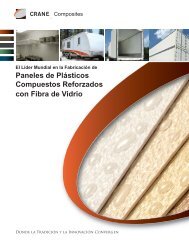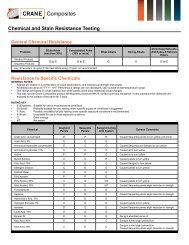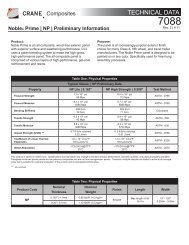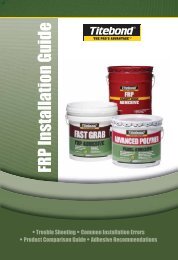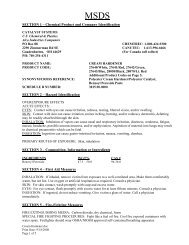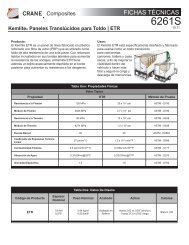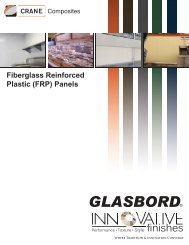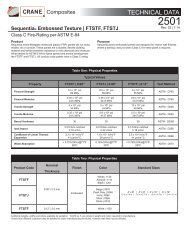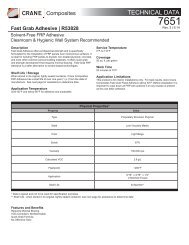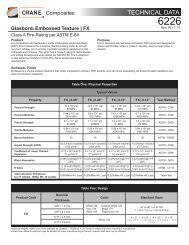SunPatch Roof Repair Guide - Crane Composites
SunPatch Roof Repair Guide - Crane Composites
SunPatch Roof Repair Guide - Crane Composites
Create successful ePaper yourself
Turn your PDF publications into a flip-book with our unique Google optimized e-Paper software.
Application Instructions for <strong>SunPatch</strong> <strong>Repair</strong> KitCAUTION: WEAR APPROPRIATE PROTECTIVE EQUIPMENT BEFORE BEGINNING REPAIRFor Translucent <strong>Roof</strong> Only:1. Identify the damaged area (figure 1). Proceed to step two for translucent roofwith no underlying foam damage. If the foam has been damaged, fill the hole orvoid with body filler or a spray foam product (e.g., Great Stuff® or other similarproduct).12. Using 80 grit sandpaper, sand an area at least 4" wider than the damage on allsides. Cut the patch to fit the sanded area. Sand until the embossment is nolonger visible and the area has a uniformly dull appearance (figure 2). A disc orbelt sander can be used. Remove the sanding dust from the patch area with adry cloth or shop vac (figure 3). Wipe clean with acetone.3. On the backside of the damaged area, apply masking tape or packing tape toseal the repair area (figure 4). This will prevent air from entering the patch fromthe backside.NOTE: Do not perform the repair if it is raining. Excessive moisture, will inhibitthe cure.Remember that the patch will begin to cure as soon as it is exposed to sunlight.Do not open the pouch until you are ready to use it.2434. Remove the smooth film from the backside of the patch (figure 5). Be sure theabraded area is dry.Lay the smooth side of the patch over the abraded area, so that the embossedside of the patch is facing up (figure 6).5. Use a squeegee to work the resin from the center to the edges (figure 7).Continue this until a small amount of resin is squeezed out around the perimeterof the patch. After the patch has been exposed to sunlight, the patch will becured in 10 to 20 minutes.6576. Check the patch to see if it is cured. It will be hard to the touch. Resinthat is not covered by the film, will feel tacky, but if the patch feels hard, it iscured. Remove the embossed film (figure 8). The film can be left in place, butmay release from the patch on its own. Remove any tape from the bottom side ofthe panel. Cover backside with silicone. Expose the resin side of the foil pouchto sunlight until cured for proper disposal.8
Application Instructions for <strong>SunPatch</strong> <strong>Repair</strong> KitCAUTION: WEAR APPROPRIATE PROTECTIVE EQUIPMENT BEFORE BEGINNING REPAIRRefrigerated <strong>Roof</strong> Only:11. Identify the damaged area (figure 1). Proceed to step two for reefer roof with nounderlying foam damage. If the foam has been damaged, fill the hole or void withbody filler or a spray foam product (e.g., Great Stuff® or other similar product).2. Using 80 grit sandpaper, sand an area at least 4" wider than the damage on allsides. Cut the patch to fit the sanded area. Sand until the embossment is nolonger visible and the area has a uniformly dull appearance (figure 2). A disc orbelt sander can be used. Remove the sanding dust from the patch area with adry cloth or shop vac (figure 3). Wipe clean with acetone.2NOTE: Do not perform the repair if it is raining. Excessive moisture, will inhibitthe cure.3Remember that the patch will begin to cure as soon as it is exposed to sunlight.Do not open the pouch until you are ready to use it.43. Remove the smooth film from the backside of the patch (figure 4). Be sure theabraded area is dry.Lay the smooth side of the patch over the abraded area, so that the embossedside of the patch is facing up (figure 5).54. Use a squeegee to work the resin from the center to the edges (figure 6).Continue this until a small amount of resin is squeezed out around the perimeterof the patch. After the patch has been exposed to sunlight, the patch will be curedin 10 to 20 minutes.65. Check the patch to see if it is cured. It will be hard to the touch. Resinthat is not covered by the film, will feel tacky, but if the patch feels hard, it iscured. Remove the embossed film (figure 7). The film can be left in place, butmay release from the patch on its own. Remove any tape from the bottom side ofthe panel. Cover backside with silicone. Expose the resin side of the foil pouch tosunlight until cured for proper disposal.76. After the patch is fully cured, you may want to spray paint the repaired area witha white exterior paint (acrylic urethanes or acrylic enamels work well) to blend inthe repaired area with the rest of the roof. Wear appropriate respiratory protection when spraying paint.www.cranecomposites.com | 1.800.435.0080 | 1.815.467.8600 | sales@cranecomposites.com<strong>Crane</strong> <strong>Composites</strong> is the manufacturer of ArmorTuf, Kemlite and a variety of other fiberglass reinforced plastic (FRP) composite panels. Inspired by the Kemlitetradition, <strong>Crane</strong> <strong>Composites</strong> has over 55 years of experience in Transportation Products and is a recognized industry leader in FRP applications.We believe all information given is accurate. It is offered in good faith, but without guarantee. Since conditions of use are beyond our control, all risksare assumed by the user. Nothing herein shall be construed as a recommendation for uses which infringe on valid patents or as extending a licenseunder valid patents.Great Stuff is a registered trademark of Insta-Foam Products, Inc. CorporationArmorTuf and Kemlite are registered trademarks of <strong>Crane</strong> <strong>Composites</strong>, Inc.Form 6335 | Rev. 11 | 2.13 | (6472)



